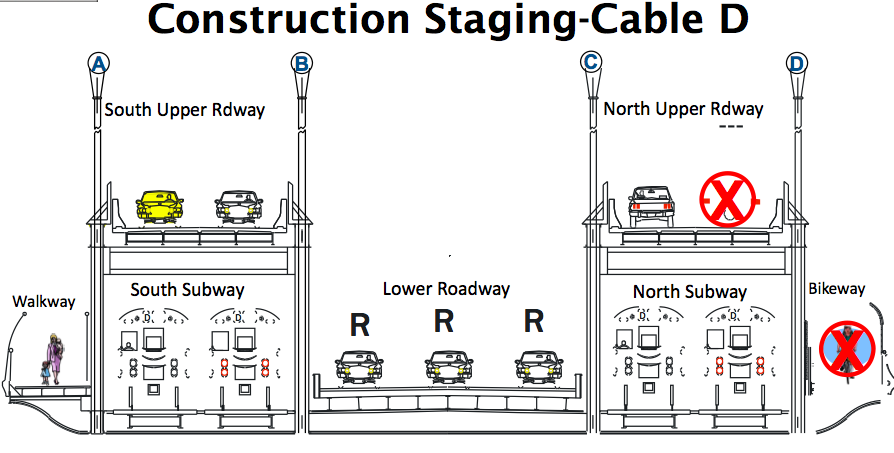Manhattan Bridge Rehab Plans Pose Challenges for Bike-Ped Safety
 DOT needs to make a strong safety plan for the year when construction will take place above the Manhattan Bridge bikeway. Image: NYCDOT
DOT needs to make a strong safety plan for the year when construction will take place above the Manhattan Bridge bikeway. Image: NYCDOTThe cables holding up the Manhattan Bridge need to be replaced, one of the final stages in a massive rehabilitation that began all the way back in 1982. The cable project will run through 2013, and for cyclists and pedestrians, the major challenges will come at the end of this year, when construction starts above the bikeway. The current plans from NYCDOT’s bridge division could put cyclists in danger when they reach the Manhattan end of the bridge, unless some additional precautions are taken.
The Manhattan Bridge is held up by four major cables and hundreds of suspenders connecting the cables and the bridge deck; the cables need repairing and the suspenders will be replaced. Work on the two cables toward the center of the bridge — "B" and "C" on the above diagram — will disrupt some vehicular lanes but won’t affect the bike or pedestrian paths.
Additionally, repairs along the southernmost cable, over the walkway, shouldn’t be too disruptive. At a presentation to Brooklyn Community Board 2 [PDF], DOT reported a plan to cover the path with protective sheds under any active construction. The walkway would be a bit cramped, as the sheds are only three feet wide, but people could walk or bike across the bridge as normal.
However, when the northern cable is under construction — a job that’s expected to take almost a full year to complete — both pedestrians and cyclists could see their trips disrupted. The sheds aren’t wide enough for bikes to pass each other, so DOT is considering rerouting cyclists to what is normally the pedestrian side and putting pedestrians under sheds on the bike side. That could pose a number of problems for the city’s second-most popular bike route over the East River.
 The Manhattan Bridge pedestrian path (right) would lead thousands of cyclists every day to Bowery near Canal, a dangerous location disconnected from the bike network.
The Manhattan Bridge pedestrian path (right) would lead thousands of cyclists every day to Bowery near Canal, a dangerous location disconnected from the bike network.The big one is safety at the Manhattan end of the bridge. "The connection on the Manhattan side to the pedestrian path is very dangerous," said Caroline Samponaro, director of bicycle advocacy at Transportation Alternatives. While the Manhattan end of the regular bike path has safe connections leading north, south, and east, the walkway would dump cyclists off at the intersection of Bowery and Canal — "two of the craziest streets downtown," in Samponaro’s words.
If DOT decides to route bikes over the walkway, she said, some combination of signage and temporary bike lanes will be necessary to keep the ever-increasing number of cyclists using the bridge safe. An average of 2,606 cyclists used the bike path daily from 7 a.m. to 7
p.m. in 2009, a number that’s probably gone up this year.
Another concern Samponaro identified is that the city would try to force all cyclists to cross to the walkway side, perhaps by putting in dismount barriers at entry points to the bikeway. "I worry that people would try and ride through anyway," she said.
Instead, she urged, "it’s important that both sides be accessible to both bikes and pedestrians." People will be confused by the switch and probably end up on the wrong side, she argued, so both sides will need to be safe for both types of users. "There’s a way to make it work," she said, even if it requires cyclists and pedestrians alike to be more aware of their surroundings.
No matter what happens, when the northern cable is under construction, biking and walking over the bridge is going to be more confusing and chaotic, leading more people to opt for the Brooklyn Bridge promenade, which will itself be narrower due to rehab work. We’re going to see even more cramped conditions where pedestrians and cyclists already struggle to share scarce space. It’s up to DOT to bring some ingenuity to the challenge of keeping all bridge users safe during this period.
